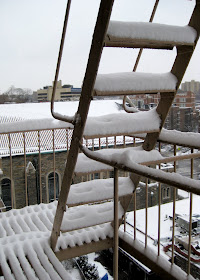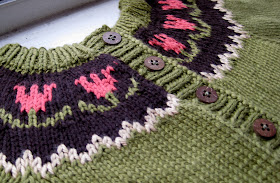
Just in time for in-like-a-lion March weather, here's a free baby cardigan pattern with spring colors of mud and grass and a line of cheerful spring tulips!
This is a top-down, circular yoke cardigan in three sizes (3-6, 6-9, and 9-12 months), with instructions on how to increase for the yoke, separate for the sleeves, and pick up stitches for button bands. It's a great pattern to try if you are a first-time sweater knitter!
Also avaliable as a free Ravelry download
here.
Matching hat available
here.
Note: There was one row missing from the yoke instructions. All increases should be worked in knit rows. Pattern has been amended 7/3/09.Tulip Yoke Baby Cardigan Pattern
Sizes: 3-6 (6-9, 9-12) months. Shown in smallest size.
Finished Measurements: 20” (21”, 22”) chest circumference
Gauge: 6 stitches and 8 rows = 1” in stockinette
Requirements:Circular or straight needles, size 3
Double-pointed needles, size 3 (optional)
Sport weight yarn (I used Knitpicks Shine Sport): MC (300-450 yards), secondary colors A (less than 100 yards), B, and C (less than 50 yards each)
Two stitch holders or pieces of scrap yarn
Tapestry needle for weaving in ends
6-8 matching buttons
MC=green (I used “leapfrog”)
A=brown (I used “fedora”)
B=pink (I used “terracotta”)
C=tan (I used “willow”)
Note: this is a top-down circular yoke sweater; it begins at the neck ribbing. It does make use of flat fair isle knitting for a brief section of the sweater (14 rows total), so be warned if flat fair isle knitting is something you hate!
Special instructions:Complete abbreviations glossary at end of this document.
m1 (make 1): my favorite way to make a stitch is to lift up and knit the right leg of the stitch one row below the stitch on the left needle. Another option is to pick up the bar between stitches and knit it through the back loop.
Reading the charts: pattern repeat is marked in red. For the tulip chart, one or two extra stitches are included next to left and right button bands to make the pattern symmetrical. The tulips are upside-down because the knitting will be done top-down. The fair isle pattern for both charts begins with a purl row.
 Directions:Yoke
Directions:YokeWith MC, cast on 79 (79, 85) stitches. Work 7 rows of k1, p1 ribbing. Work one row purl. Switch to A and work two rows stockinette. In next row, increase 16 (16, 20) stitches evenly across row as follows: k2 (2, 4), *m1, k5 (5, 4), rep. from * 14 (14, 18) times, m1, k2 (2, 5). 95 (95, 105) st. Work 1 more row stockinette. In next row, increase 28 (28, 28) stitches evenly across row as follows: k7(7,12), *m1, k3, rep. from * 26 (26, 26) times, m1, k7 (7, 12). 123 (123, 133) st.
In next row (WS), join B and begin working tulip chart. You will work 12 (12, 13) repeats of the tulips. Remember to work the extra stitch or two at the beginning of first repeat and end of last repeat to center the design on yoke. After row 10 of the tulip chart, work one row in color A, then in the next row increase 28 (28, 28) stitches evenly across row as follows: k8 (8, 13), *m1, k4, rep from * 26 (26, 26) times, m1, k7 (7, 12). 151 (151, 161) st. Work 3 rows stockinette (in color A). In next row, increase 17 (17, 19) stitches evenly across row as follows: k3 (3, 4), *m1, k9, rep. from * 15 (15, 17) times, m1, k4 (4, 4). 168 (168, 180) st.

In next row (WS), join C and begin working zigzag chart. You will work 42 (42, 45) repeats of the zigzags. After row 4, work one row stockinette in MC, placing markers as follows: p24 (24, 26), place marker (pm), p36 (36, 38), pm, p48 (48, 52), pm, p36 (36, 38), pm, p24 (24, 26).

In next row and following 5 (7, 7) RS rows, work raglan increases: *k to marker, m1, slip marker, m1, rep. from *, k to end. 216 (232, 244) st.
BodyIn next RS row, divide for sleeves as follows: knit to first marker, place stitches between first and second markers on a holder or piece of scrap yarn, knit to third marker, place stitches between third and fourth markers on a holder or piece of scrap yarn, knit to end. You can drop the markers in this row. Continue body in stockinette until it measures 9½ (10½, 11½) inches from cast-on. Then work 12 rows of k1, p1 rib and bind off.
SleevesPlace one sleeve’s stitches back on needles and rejoin MC yarn. Work back-and-forth or in the round. If you work back-and-forth, cast on one selvedge stitch at each side to use for seaming up later. Work 12 rows stockinette. In next row/round (RS), k1, ssk, work to 3 stitches before end, k2tog, k1. Work 11 more rows/rounds. Repeat these 12 rows/rounds 3 more times. Work 0 (4, 8) more rows/rounds stockinette. Sleeve should be 6 (6½, 7) inches from armpit. If it is not, continue in stockinette until it is. In next row/round, *k4, k2tog, repeat from * to end. Work 8 rows k1, p1 rib and bind off. Repeat with other sleeve.
Buttonhole bandsPick up 3 stitches for every 4 rows along left front cardigan edge for button band. Work 8 rows k1, p1 rib and bind off. Pick up same number of stitches along right front cardigan edge. Work 3 rows k1, p1 rib. In next row, work eyelet buttonholes in the places you would like them (make an eyelet buttonhole by working up to the place you’d like the buttonhole, then YO, k2tog, and continue to the next spot you’d like a buttonhole). Work 4 more rows k1, p1 rib and bind off.
FinishingWeave in ends, block, and sew on buttons!
 Abbreviations used in this pattern:k: knitk2tog: knit two stitches togetherp: purlpm: place markerrep from *: go back in this line of instructions to the *. Repeat the instructions from the * to the end of the line as many times as specified.RS: right side (usually knit side)ssk: slip the next two stitches as if to knit, then knit them together through the back loops.st: stitchesWS: wrong side (usually purl side)YO: yarn over (move yarn to front of needle as if to purl, but knit the next stitch, making a loop where the yarn went over the needle.
Abbreviations used in this pattern:k: knitk2tog: knit two stitches togetherp: purlpm: place markerrep from *: go back in this line of instructions to the *. Repeat the instructions from the * to the end of the line as many times as specified.RS: right side (usually knit side)ssk: slip the next two stitches as if to knit, then knit them together through the back loops.st: stitchesWS: wrong side (usually purl side)YO: yarn over (move yarn to front of needle as if to purl, but knit the next stitch, making a loop where the yarn went over the needle. Copyright 2009 by Jennifer Little of Looking Glass Knits. Please do not sell this pattern or sweaters knit for it for your own profit.
Copyright 2009 by Jennifer Little of Looking Glass Knits. Please do not sell this pattern or sweaters knit for it for your own profit.
































